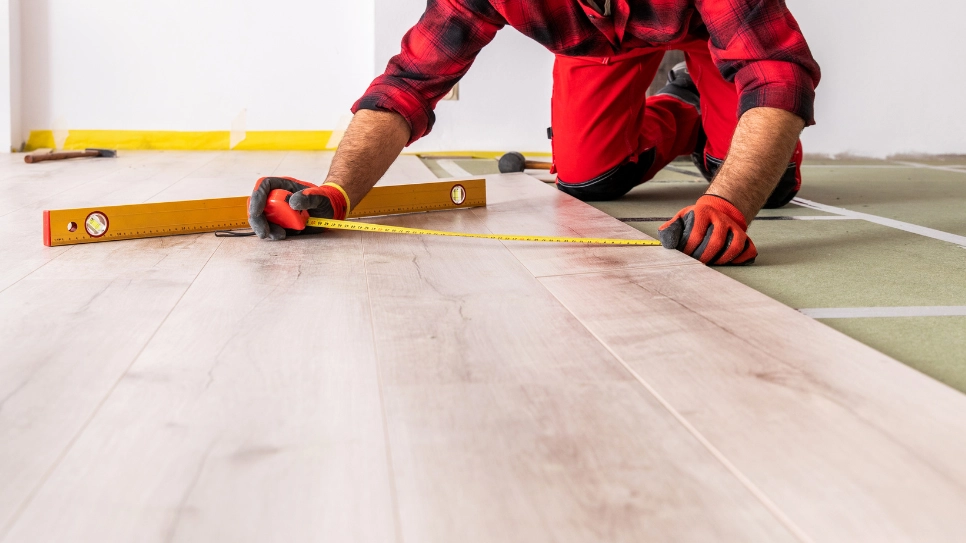Set your prices too high, and you will miss out on customers. Set them too low, and you are left with no profit.
Don’t set your price based on intuition — always look at your costs and do the math first.
Adapt your prices by looking at the competition and the perceived value you are creating for your clients.
How to set the price of your service
To get the pricing right, you first need to know all your costs. Then add a margin, reasonable to clients and profitable for your business. This approach is called cost-based pricing.

1. Calculate your costs
Cost is the investment you need to make to do the job. Break down the entire project from start to finish.
For example, if you are in the floor installation business, the job might be the following:
- Measurements at the location
- Buying and collecting the materials
- Preparing the work area, installing underlayment
- Laying the floor
- Cleaning up and removing the waste
Once you have all the components, work through each and note down the costs on paper or a computer.
Materials

Write down the quantities of materials you need and sum the costs. Add 10% of each material to cover any shortfall. The cost of materials is easy to keep track of since you have to buy them. Make sure you store the receipts.
For the flooring example: You need material for 30 square meters of laminate floor. The cost of laminate is R200 per square meter. Add R1000 worth of laminate just in case. It is better than running out of it, and you can also use it in your next project. Include the cost for underlayment and tape - R700.

Labour
Estimate how much work is needed to finish the project and figure out who will be on the job besides yourself. Make sure you don’t underestimate how long things take. Multiply the number of hours by the hourly wages to get your labour cost.

Flooring example: You need an hour to measure and collect the materials. The installation of 30 meters of a laminate floor requires 4 hours and an additional hour to clean up and remove the waste — 6 hours total. One hour of your work costs R50.

Overhead
These are the indirect costs of running your business. They can include petrol, tools, office rent, phone bill, computers, advertising and subscriptions (for lead-generation services like Procompare), or wages for administration staff.
Add a portion of these costs in the price of each of your jobs. Start by adding up all your overhead costs for one month. Divide your overhead cost by your direct costs and multiply by 100 to get an overhead rate in percentage.

Flooring example: You calculated your labour and material costs are R100 000 per month, and you spend an additional R25 000 on everything else. Your overhead rate is 25%, which means for every rand of direct costs, you spend additional R0.25 on overhead. So, you need to add 25 cents to every rand of your direct costs. For the laminate floor mentioned above, that would be:

2. Come up with a reasonable profit
Once you determine the costs of your services, you need to ensure you achieve a profit. Your margin is the profit you want to make. Your markup is the amount you need to add to your costs to reach that margin.

Let’s say your objective is a profit margin of 10%. You’ll need to mark up the costs of installing a laminate floor by 11.1%, or R1 100, to reach that margin, which means the price of the job will be R11 100.

Or you can keep in mind the pricing psychology and round up the amount you want to pocket to R1000. Your markup is precisely 10%, and your profit margin is around 9%.

In the case of the 30 sqm of laminate floor, there isn’t a significant difference between the two. The difference can add up quickly through time.
Here are some rough percentages for determining profit margins in relation to markup:
| Profit margin | Markup |
|---|---|
| 5% | 5.2% |
| 7% | 7.5 |
| 9.1% | 10% |
| 10% | 11.1% |
| 15% | 17.6% |
| 20% | 25% |
You can also help yourself with:
If you need an accountant to do these calculations for you, you can get business accounting quotes here on Procompare.
3. Choose the appropriate pricing model
Fixed-rate
Clients love a fixed rate. It ensures the job stays within their budget. But for you, the fixed price model only works for simple recurring jobs you have lots of experience with. If a project takes more time and money than expected to complete, you risk losing money.
Discuss everything with a client beforehand to estimate the amount of work needed and calculate all the costs. Always have some leeway when setting a fixed rate.
The installation of 30 square meters of laminate floor will cost you R11 000.
Hourly rate
Hourly rate guarantees that you get paid for all your time working. You can easily bill unexpected additional work without re-quoting. Use hourly rates for all unfamiliar, non-standard work.
In our experience, 30 square meters of laminate floor takes 6 hours to finish. Our hourly rate is R500. Plus the cost of the material.
Clients are comfortable using hourly rates and have an easier time deciding since these prices tend to look relatively low.
4. Add it all together

Now that you know your costs, how much profit you want to make and what kind of rate works for you, it’s time to name your price.
You have seen and measured the scope of work and laying the laminate floor is pretty straightforward. You will send a quote with a fixed price for this job.
Here’s the equation for the total price:

- Double-check your math!
- If the price seems too high or low, go through every aspect again and adjust accordingly.
- Before you set this as your permanent pricing formula, consider applying it to a few business cases to understand how it works in practice.

The cost-plus approach is a good starting point, best for new businesses unsure of how to set the price of their services. But it doesn’t take into account other vital things, like the market, competitors and the perceived value of your service.
Changing the price of your services
Monitoring your profitability, the market and competition
- You need to understand the profitability of your company over time. By the 15th of every month, look at your financial statements from the previous month. Are the costs rising? Can you optimise the process, reduce the amount of labour needed or cut the materials costs? What else is going on?
- What are your competitors charging for similar services? Under market-based pricing, businesses adjust their prices according to the competition.
- Get to know your clients and how much value your service brings them. A value-based pricing strategy is when companies price their products or services based on what the customer is willing to pay. To your customer, the key factor in their decision may not be low price, but the perceived value of your service to them.
Don’t base your pricing decisions on what the competition is doing, but you should be aware of what they are doing and how much they charge.
How can you find out what others are charging? Here are our cost guides for different services.

Raising your prices
When to raise your prices
- If you’re super busy, your time becomes more valuable. You could charge more to make it worth your while, reduce the amount of work (and keep your profitability intact).
- If your costs are rising and your profitability is falling due to market reasons, like supply chain disruptions or increasing prices of energy and materials.
- If your competitors are raising prices. If the competition is charging more, that is a signal that market can tolerate a price increase.
- If your clients say you're a bargain. If customers repeat what a great value your services are, that may be a clue you're charging too little.
How to raise your prices
- Don't raise prices too much all at once. Raise prices in small bumps of two or three price increases over a year.
- Don't raise prices across the board. Clients may be more forgiving of price increases for particular services or segments and not for others.
When to lower your prices?
- If you managed to cut your costs in any way. In that case, your prices will be lower than the competition’s, and you can expect to win more work.
- If the competition is lowering their prices. Find out how they can do it and try to follow. Your prices have to stay competitive.
- If you are losing or not getting work due to the high prices of your service.
You have to monitor your price and keep your costs under control constantly. Do the math before any change, but experiment with different offers and packages. Make sure you are both competitive in the market and making enough money from your business. Things get easier with experience.



